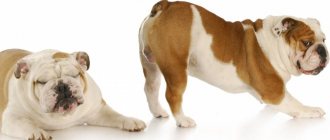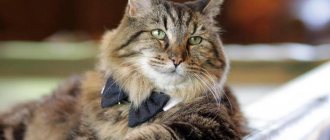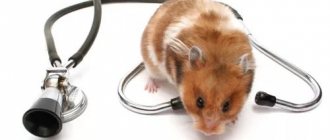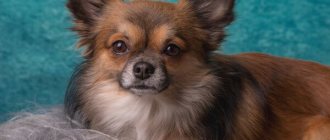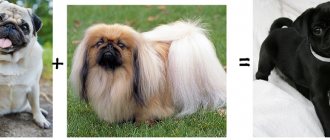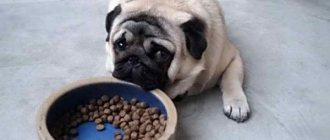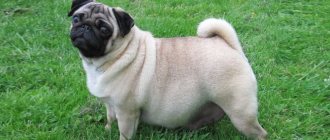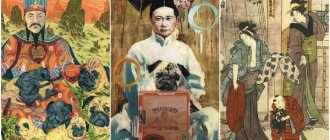A remarkable fact is that previously the color of a dog literally decided the matter of life and death. Beige pugs were the favorites of Chinese emperors and real darlings of fate. The dogs had their own servants, half tones were dedicated to them, they were presented as a sign of recognition.
Blacks were unlucky from birth: the appearance of such a puppy in a litter was considered a curse, for which they were mercilessly exterminated. Nowadays, the attitude towards colors is much simpler and almost each has its own admirers.
Origin of the breed and character traits
The first representatives of the species were bred in China long before our era. The dogs were kept by monks from the Tibetan peaks, emperors, and noble people. Much later, in the 17th-19th centuries, English breeders were involved in breeding the breed.
Welcoming, friendly dogs are excellent companions and nannies.
The pet will never offend a child and is not inclined to show aggression towards others and strangers. Sedentary, slightly lazy pugs are suitable for those who cannot devote a long time to games and walks in the fresh air.
This is interesting: 5 more facts you need to know before buying a pug
Left alone, an adult pug will not chew slippers or tear wallpaper, but will go to bed before the owner arrives. Some representatives of the breed are distinguished by their strong stubbornness and achieve what they want.
Origin story
The Pug breed is quite ancient . The first mention of pugs dates back to the times of ancient China, where these dogs were favorites of emperors.
They were also bred by Tibetan monks; pugs were temple guards. It was from there that dogs were brought to Europe. Of all the breeds, pugs are the most mysterious; their appearance has been associated with various myths and legends.
Scientists today argue about their homeland.
Many say that the breed originated in the Far East, others think in Africa, and still others in Europe . Most are inclined to believe that they appeared in the East.
Pugs were mentioned in ancient Chinese manuscripts; there are even images of such dogs in jade and ceramic rosaries.
Pugs lived in the imperial palace and never left it; the dogs had a personal servant and a collar with a bell. This privileged position is explained by the fact that the supra-forehead folds resemble a Chinese character, which is why the folds on the pug’s forehead were called the imperial sign.
In China, there were two varieties of similar dogs, differing only in long hair, “Ha Pa” and “Lo Jie” . "Ha Pa" were long-haired. Most likely, the ancestors of pugs were “Lo Jie”, they looked like Pekingese, but had short hair.
In 1553, the pug came to France, then to the Netherlands, and from there the English king William of Orange brought them to England in 1689.
Empress Josephine, Napoleon's first wife, had a beloved pug named "Fortune".
Nowadays, many celebrities such as fashion designer Valentino and others keep pugs..
Recognized colors
Pug colors come in a variety of shades, some of which are valued much higher than others.
Fawn
Brown or beige-brown wool. The standard, most common color of the breed.
Apricot (apricot)
Beige color with hints of apricot. It is also called sunlight fawn, which means “fawn in the sunlight.”
Mixes with other breeds
To get an unusual breed, dogs are often crossed with other breeds. For example, a pug was crossed with a Chinese Crested.
Khokhlomops is not hairy, but bald, and on some areas of the skin there are tufts (fur) . The size and weight are slightly less than that of a pug. He is good-natured by nature and cannot stand loneliness. The appearance is unusual and specific.
Since ancient times, the Chinese Crested has been the personification of love and devotion. The homeland of these dogs is Central America.
Beagle - A mixture of a pug and a beagle is called a puggle . This is an unofficial standard. Not very picky about care, gets along well in an apartment. Friendly, endowed with high intelligence. They love to play and run.
Pug Bull is a mix with a French Bulldog. They are similar in appearance but larger, and have the same health problems: obesity, breathing problems.
American R. Mons crossed a Pekingese and a pug . The offspring were given the nickname Lo-shi pug. Outwardly, they are more squat, reminiscent of their parents due to the folds on their faces. These mestizos have better health and good immunity. The pet is fluffy. He combines the attractiveness and determination of the Pekingese and the good nature and positive attitude of the Pug.
The main trait of pugs is loyalty and kindness . The pug is a civilized dog. He is used to comfort and warmth and cannot tolerate extreme heat and frost. They are quick-witted and smart, but despite this they have stubbornness.
Therefore, the owner of the dog may encounter stubborn antics of the dog during training; his upbringing should be based on mutual understanding and equality.
A dog may pretend that it has suddenly become deaf or retreat somewhere if you raise your voice at it. It is important to raise a dog and instill in it decent behavior; keeping a pug in good physical shape will ensure a healthy diet.
IMPORTANT!
Contact your veterinarian promptly and do not forget about vaccinations.
The eyes require special attention; in pugs this is the most vulnerable organ. Clean and dry skin folds.
If you decide to get a pug, buy a dog from a kennel, turning to professionals for help, because an inexperienced person cannot see small deviations from the norm.
You can also contact an experienced breeder. A puppy with a good pedigree and supporting documents will be able to participate in exhibitions in the future.
It is very important to monitor the dog's health during its growth period.
All kinds of pathologies can cause delays in the physical and mental development of the puppy.
Good care and balanced nutrition will help to fully unlock the animal's genetic potential and lay the foundation for a healthy and fulfilling life for your pug .
Unusual colors of pugs
There are puppies of unusual, not quite standard colors for the breed. An unpopular appearance may indicate a mistake by the breeder and requires a detailed study of the dog's pedigree.
Albinos
White albinos have a dark muzzle. There are individual beige hairs in the pug's fur.
Steel color
Quite faded gray, light (unpopular).
Shades of chocolate
Rich tone, smooth shiny coat, brown nose, brown eyes.
Fawn color
Classic beige with a hint of yellow, while the animal’s face is not black, but chocolate or brown.
Tiger pugs
Spotted, tabby or brindle dogs are rare and not recognized by the FCI, but are highly prized in America.
Expert opinion
Anna Abramenko
An avid dog lover. Experience in veterinary medicine since 2009.
Ask a Question
Pets of non-standard coat color are not allowed to participate in exhibitions and competitions, but pugs are willingly bought as pets.
Rare species
Most often you can find pugs of the following colors:
- yellowish;
- silver;
- beige;
- black.
Reference! Peach-colored pugs are considered the most expensive and rare at the moment.
Other colors are much less common. As a rule, such puppies quickly find their owners, although they are sold much more expensive than their counterparts. Connoisseurs of non-standard beauty are not deterred even by the fact that some colors are considered “culled”, as is the case with brindle color.
As for the most unusual colors, albinos are one of them. These are pure white dogs. Over the entire period, dog handlers have recorded less than ten cases of the birth of such puppies.
Color assessment at shows
The most expensive dogs are those that are black or peach in color. Such pugs are subject to special requirements at exhibitions. The quality and purity of the animal's fur is assessed; the presence of hairs of a foreign color is unacceptable.
Expert opinion
Anna Abramenko
An avid dog lover. Experience in veterinary medicine since 2009.
Ask a Question
The velvety, glossy coat of rich black pigment with hints of blue is rare, and all because in Ancient China such black pugs were considered a genetic error.
Only the British, having started breeding the breed, thought differently. During competitive judging, the presence of a white spot on the chest is allowed, but preference will still be given to completely black individuals.
Light pigmentation is more common in competitive dogs. They are subject to the following requirements:
- resin color of nose and claws;
- mandatory presence of a dark mask on the face;
- direct and imperceptible transition from forehead to nose;
- curl-shaped tail;
- dense structure, strong straight legs;
- a stripe of mustard and dark hair from neck to tail.
What color are pugs born?
When a pug baby is born, it can be any color: beige, gray, brown, etc. But the fact is that:
- the initial color of the fur is not an indicator of what it will be like in a year or two;
- On average, up to one and a half years, the color of a pug’s coat can change dramatically, that is, it can both lighten and darken.
But it is reliably known that a black pug always gives birth to a black puppy (regardless of which of the parents is black and what shade the second dog is).
Care depending on color
Charcoal is not only a rare shade, but also requires more careful care. Black-haired individuals should not be kept in the sun for a long time, otherwise the fur will acquire signs of fading. For bathing, you should choose professional shampoos for dogs with dark hair. Otherwise, caring for black pugs differs little from keeping their relatives.
Dogs of this breed are prone to weight gain; such animals should not be overfed. Signs of obesity will not allow the pet to participate in competitions and exhibitions, and the use of low-quality food will have a bad effect on the animal’s coat.
Expert opinion
Anna Abramenko
An avid dog lover. Experience in veterinary medicine since 2009.
Ask a Question
Pugs should not be overheated in the sun. Short, thick hair should be combed thoroughly, as dogs shed heavily. It is necessary to monitor your pet's oral cavity, brush teeth, trim claws, and care for the area around the eyes and ears.
Breed standard
The pug is a compact, square build. Its proportions in width and height are almost the same.
In the standard, the optimal height for females is 25-30.5 cm, for males 30.5-33 cm, weight 7 kg:
- The bridge of the nose should be slightly pronounced, absolutely straight, not snub-nosed. The folds on the forehead are as symmetrical as possible, the nose is black (light is a big drawback).
- The eyes are large, protruding and widely set. The eyes should be in line with the nose. Light-colored eyes, eyes where the whites are clearly visible are disadvantages.
- The bite is a slight bite of the lower jaw forward, but the incisors should be straight.
- The thin, tight-fitting ears are divided into two “rose” shapes – small ears located above the head with the inner part visible, or “buttons” laid forward tightly pressed to the head.
- The neck is the optimal length, not too short and not too long.
- The body is short, strong with good muscles.
- Limbs straight, strong
- The tail is short and set high, curled into a ring.
- The coat is short, smooth and soft.
- Color: silver, apricot, beige and black. Light colors have a black mask and a stripe on the ridge.
Read more about pugs here.
Which puppy to choose
When choosing a future pet, you need to know about the classes of individuals:
- Pat. These dogs are bought as pets. Pugs are not suitable for exhibitions due to non-compliance with standards.
- Show. The breed is raised for competitive victories; pugs have an impeccable pedigree, the highest compliance with standard requirements and the highest price.
- Breed. Representatives of this species are cheaper than the show, but are not much inferior in other respects. With effort, the pug owner will achieve the highest results in assessing the dog.
It is not recommended to buy animals under 6-7 months of age. At an early age, it is still unclear which class the pet belongs to. And unscrupulous sellers or scammers may offer pet animals at show prices.
Types of pug puppies:
- Lightweight (terrier). Long neck, elongated and straight torso. This type of dog is in demand and often participates in exhibitions.
- Bulldog. It is distinguished by a wide chest, oblique shoulder blades, and large front paws.
- Shar Pei is the most unclaimed option. Abundance of skin folds, tendency to obesity, irregular topline. Dogs are not allowed to show, although not so long ago the participation of Shar-Pei pugs in the distribution of awards was not prohibited.
The puppy to be purchased must be healthy, with a proportional body, glossy coat without blemishes, skin without rashes or redness, clean ears and eyes without signs of inflammation. The dog should not emit an unpleasant odor, liquid from the nose, liquid or transparent is allowed.
Cultural attitudes towards pug color
It is generally accepted that black pugs have a nasty and complex disposition, but this is not at all the case. This opinion was formed under myths from the past. Back then, all black animals had a bad reputation. Like dogs of other colors, with the proper approach to education, they are no different from others. Still, according to the observation of breeders, black pugs are a little more active than other representatives of this breed, but this is rather a subjective opinion.
The most prestigious color is considered beige - this is a classic of the breed. Such dogs are in steady demand among amateurs and professional breeders. Moreover, according to historians, dogs of exactly this color lived with the Chinese emperors, and this circumstance became decisive in relation to dogs of this color. Such specimens are considered the most purebred, because China is the birthplace of pugs.
All pugs, regardless of coat color, have a stubborn character and are quite lazy, so they need to be trained from an early age, and if you miss the moment, you will grow up to be a lazy couch potato.
Return to content
Photo and video review
Before making a choice in favor of a breed, it is advisable to familiarize yourself with photos and videos. In them you can compare shades of colors, prices, and visually study the characteristics of the breed.
By choosing a girl or boy pug, the owner will receive a loyal, intelligent friend. It doesn’t matter whether he becomes the star of the exhibition or whether he will lazily lie on the sofa.
Questions and answers
What color are pugs born?
When a pug baby is just born, it can be any color: beige, gray, brown, etc. However, the initial color of the fur is not an indicator of what it will be like in a year or two. On average, up to one and a half years, the color of a pug’s coat can change dramatically, that is, it can both lighten and darken.
Are there white pugs?
Yes, there are. However, do not confuse white coloring with albinism. In the first case, the dog still has a dark face and dark eyes. The coat of a white dog can have a shade from snow-white to a more pronounced and delicate milky color. And albino pets have light eyes and a completely pink muzzle.
How is a black pug different from others?
The character and behavior of dogs of the “black” color correspond to the characteristics of the breed. They are cheerful, smart and funny. They are just as attached to their owner, love all people, value human society, and are bored when alone. It is a mistake to take such unusual puppies in the expectation that they have a special character. Don't expect them to be more affectionate or active. No! Dark pugs differ from other representatives of the breed only in their exterior.
The main difference is that the jet-black representatives of the breed have slightly coarser coats than light-colored pugs. And if you look closely at their skin, you can see that it has a bluish tint. In addition, those with dark coats have fewer hair follicles, so they will cause you less problems during shedding.
Beige and black pug - comparison
Let's compare coal pugs with the most common subspecies - fawn doggies.
- The fawn (beige) pug has a mask on its face and an “acne” stripe on its back. The black one does not have such marks.
- The coat color of the beige (fawn) pug varies from light beige to brown. Dark pugs have a uniform color.
- Light-colored dogs have a dark spot (“diamond”) on their forehead. Black individuals may only have a small white spot on the chest.
- Fawn dogs shed more than dark dogs.
- Among black dogs there are representatives with one layer of fur.
- The coat of dark dogs turns gray at the age of 8-10 years.
Important: coat color does not in any way affect the dog’s personality!
How do pugs get black coat color - genetics
Two genes are responsible for the black coat color of this breed: the dominant K gene and the B gene, which is involved in the synthesis of black eumelanin. White hairs and spots on dark coats may appear in areas of primary depigmentation, which are responsible for the recessive ss genes. The complete genetic formula for black coloring looks like this: ayayBBC-DDEmEmK-S-
What kind of puppies can black parents have?
Genetics is a science, a complex science for the uninitiated. Breeders are required to know the basic rules of crossing pets and the genetic code of breeding animals in order to obtain the desired dog exteriors when mating. It is absolutely not necessary for ordinary people to understand genetic formulas. However, it may be interesting to know in advance what kind of puppy you can get from a black pug.
Basic mating rules:
- When crossing two black dogs, puppies can be produced in all four colors established by the breed standard: black, silver, beige and apricot.
- A black and beige dog can produce either only black puppies, or black and beige ones.
- Don't expect a black pug puppy in a litter from two beige parents.
Important: crossing colors does not improve coat quality and color - usually breeders focus on breeding pugs of a specific color.
Education and training
Raising a pug should be done from the first days of its appearance in the house. These dogs are easy to teach to go to the toilet in a diaper or in a special litter box. They quickly understand simple commands. Proper upbringing in the first 6 months will make life much easier for the owners later. After all, a pet that is not raised properly will become stubborn and uncontrollable.
But more advanced pug training can be challenging. These dogs are stubborn, smart, and have a developed sense of self-esteem, so it is not permissible to raise your voice or even hit your pet. When training, only encouragement works. The pug quickly understands that a treat awaits him for correctly executed commands. It’s just not recommended to give them often, so as not to require treatment for obesity, it’s better to praise and caress.
Care and maintenance
Oh, watermelon!
Caring for a pug will not require extra effort from the owner. The short and smooth coat does not require professional grooming; it is enough to comb it at home. During the molting period, which happens twice a year, it is recommended to do this daily, and the rest of the time - less often. By the way, the future owner should know that pugs shed surprisingly profusely and be prepared for frequent cleanings. But experts advise bathing your pet as rarely as possible so as not to disturb the natural protective barrier on its skin. The best option is bathing procedures once a month.
Folds and wrinkles on the face require constant and close attention. They must be regularly and thoroughly cleaned of food particles and debris that gets there while being outside. This will avoid inflammatory processes and infections.
The duration of daily walks depends on their intensity. A leisurely walk can take up to an hour and a half, but a light jog should not exceed 10-15 minutes, since your pet's respiratory system is not designed for marathon races. In addition, it is imperative to take into account the temperature and humidity of the air - for a pug, hypothermia or overheating can, without exaggeration, become fatal. Short hair without a thick undercoat does not protect it from low temperatures, so during the cold season it is important not to forget about special clothing. The structural features of the muzzle do not allow excess heat to be effectively removed, and even with an increase in body temperature by 3-4 ºС, your pet may die. Therefore, in the summer it must be kept in an air-conditioned room.
Running pug
How to properly care for black fur
The black pug is a dog of elite blood and requires increased, competent care. First of all, this concerns the folds on the face, which must be inspected daily for food, dust, dirt, and, as a result, the development of fungi and microbes. The folds are carefully lifted, washed or wiped with a damp cloth, and treated with antiseptic preparations. After cleansing, wipe thoroughly to ensure no moisture remains.
The pug should be bathed no more than once every three months or as it gets dirty with shampoos specially designed for this type of color. The rest of the time, simply wipe it with a damp cloth. It is necessary to check your pet’s mouth every day: its gums are susceptible to frequent infection and inflammation. Pug eyes should be treated daily with chamomile decoction or just warm water.
Pugs shed heavily all year round, with black ones shedding significantly more than light colored ones. The hairs should be combed out daily using a blunt-toothed comb in the direction of hair growth. It is convenient to remove loose hair with a brush, washcloth, or a special rubber mitten.
Baby care
The beauty and brightness of a pug's color largely depends on its diet. The diet should contain:
- lean meat - beef, lamb;
- boiled porridge;
- chopped vegetables, fruits;
- boiled sea fish without bones;
- cottage cheese, fermented milk products;
- vitamins, macro and microelements.
You need to feed one thing - either dry balanced food, or natural food. Preference is given to natural products.
Note! Before serving, dry food is softened with kefir or warm water.
Pug puppies begin to be fed every three hours, and at the age of three months they are transferred to five feedings a day. At this age, it is necessary to give your baby raw liver, boiled boneless fish and minced meat. From the age of four months, the puppy can already be fed the diet of an adult dog 4 times a day. From 6 months three meals a day are introduced. An adult dog is fed 2 times a day.
Additional Information! Pugs are big gluttons. Overfeeding your pet should not be allowed, as it will lead to obesity.
You cannot feed your dog fatty foods, smoked meats, foods with spices, sweets, baked goods; begging must be stopped. The excess gas that people talk about is a product of improper feeding of the pet, as well as snoring, which can occur from excessive fatness of the baby.
How to buy a puppy
If you decide to purchase a pug puppy, you need to contact a kennel. The cost of a dog there will be higher than from the hands, but there is a guarantee that the pet will be purebred. The price of a pug can be from 15 to 45 thousand rubles. It depends on the color, the pedigree of the parents, and the fame of the nursery.
Enjoy Your Bath…
Before choosing, it is recommended to study photos and reviews of breeders. When purchasing, you need to carefully examine the puppy. He should be healthy, cheerful, active.
The owners of these amazingly charming and playful animals describe them only in positive terms. This pet will become a devoted friend and a constant source of positivity. With proper care and feeding, he will delight all family members for a long time with his positive character and friendliness.
Do they come with a “mask” and spots?
Black pug - must be clean, without inclusions of red, white or beige.
Other colors can be diluted with the following color points:
- The mask is a black edging that covers the nose and chin or the entire face, including the area of the brow ridges.
- The belt is a barely noticeable line running along the spine - from the back of the head to the tail.
- Diamond is a black or dark brown spot right on the forehead. Having it is an advantage.
- Black ears or presence of moles on the skin .

